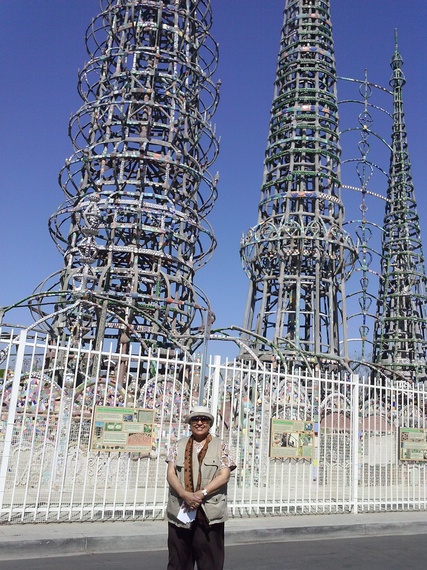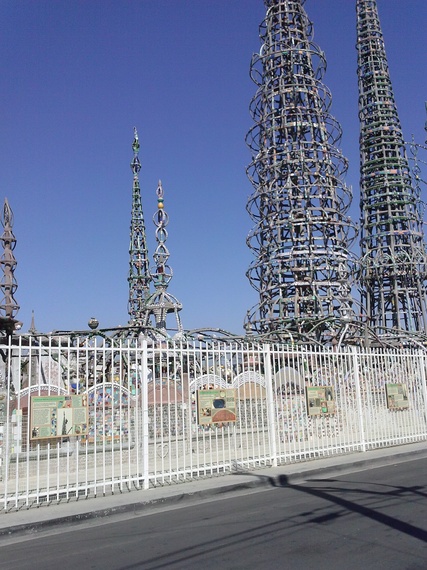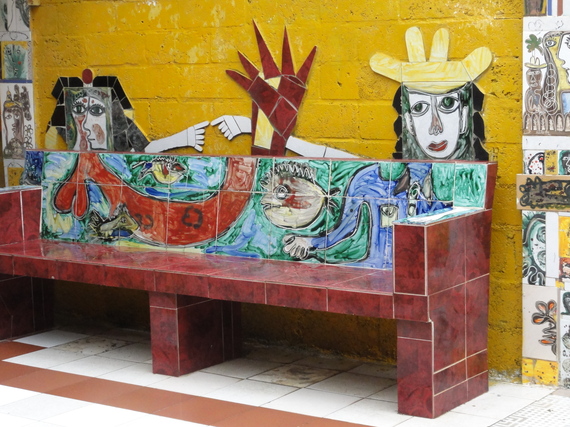Los Angeles is one of the epicenters of my life's work in arts management and cultural discovery. During my years of living in this entertainment capital, with its super-sized landscape, I loved navigating its maze of freeways and discovering a plethora of arts and cultural treasures around L.A. County. I fondly remember setting out in our grocery getter (a station wagon, that is) one Sunday afternoon in the late 1970s with my two little boys to visit one particular Los Angeles treasure: The Watts Towers. Before the visit, I had talked with several artist friends who suggested it was a very special place, and added that a pilgrimage to this national landmark site was certainly in order for a treasure hunter like myself.
As we parked across the street from the complex, my oldest son, David, about ten at the time, quizzically looked at me and said, "Mom, it looks kinda like a colorful rocket launch site that was maybe built in the wrong place?" As I vaguely recall, I responded that it did appear to be "other worldly." But as I got closer, I thought about Gaudi's mosaic installations and, of course, his still incomplete cathedral in Barcelona. I quickly recognized that although this spectacular construction had some European antecedents, it was not a copycat of any monumental installations in Europe or anywhere else for that matter.
I was an art history student at Oberlin College in the 60s when I read about (Saba to), Simon Rodia, the Italian self-taught artisan who singlehandedly forged and sculpted the Towers over a 34-year period beginning in 1923. His neighbors, mostly Black and Hispanic working class homeowners, watched him fabricate a series of 17 structures, which he called "Maestro Pueblo" (our town), including three towers, the tallest of which is 99 and one-half feet tall. Years later, I watched a documentary film that presented the small-framed, short little man, scurrying up the towers with no scaffolding. He carried his tools secured in a window washer's belt, and a bucket thrown over his arm.
The metal armatures were embellished with glass, ceramic and thousands of found objects and materials of an astonishing variety of textures and sizes. He used steel rods to frame, and mortar to secure the elements. Using found objects from bottle caps to small appliances, this folk art masterpiece is an almost dizzying kaleidoscope of patterns and colors -- a real feast for the eyes. It was really an environment -- with places to sit, stand and admire and maybe even hide from the streetscape in little corridors.
Simon, early in the development of the site, reported to visitors that he wanted to build something BIG. When asked why he built it he usually answered, "For me."
His neighbors called him Sam. He bought the parcel on 107th Street in 1923 and worked diligently on his creation evenings and weekends. He supported himself as a construction worker and tile setter for most of the time he lived in his one room house on the property. He reportedly told visitors that he didn't hire helpers because he couldn't afford to pay them. A usually hospitable neighbor, he often let his neighbors use his property for special events. There were, however, reportedly times when minor conflicts arose; but they didn't impede his progress. In 1955, he abruptly left the property, deeded it to a neighbor, and moved to Martinez, California to be near his family. Over the years, it changed hands several times and was almost torn down. But it has survived. Thank God.
My recent return to the Towers was 30-plus years after my first visit. I was thrilled to see that it remains a dominant presence in this Watts neighborhood. It's now secured by a tall metal white fence, and open for a small admission fee with limited hours, to the public.
The additions to the property include a cultural center where a variety of activities including exhibitions by local artists are mounted regularly. There are also special events including a "Day of the Drum Festival" held every year in September.
A lot of local history has happened in and around the Towers over the last four decades. Interestingly, during the Watts Riots in 1964, the Towers were not touched. The Northridge Earthquake in 1994 did extensive damage to several elements, but restoration was funded and the site opened again to the public in 2001. The property is now owned by the State of California and managed by the Los Angeles Department of Cultural Affairs. Thirteen years after earlier renovation, another round is planned.
My visit this year to Watts reminded me so much of a trip I made in 2012 to Havana, where I toured a remarkable arts space and neighborhood called Fusterland, developed and orchestrated by Jose Fuster, a painter and mosaic artist. This visionary man (with family participation) has built a complex of vibrant structures radiating from a small house that he bought decades ago on a modest street of single-family houses, just outside Havana. I was mesmerized by the imaginative settings that he has fashioned in a complex of many habitats for sitting, climbing and walking. His mosaic complex, inspired by Cuban history and culture, and European artists like Picasso, is constructed with found objects and is a magnet for tourists, plus the pride of a neighborhood of working class Cubans -- an environment much like some of the houses on 107th Street in LA. Several of the houses on the street of Fusterland have mosaic embellishments -- just like Rodia's street. I wonder if Fuster has ever been to Watts?
Rodia's old neighborhood remains quiet. The Towers still count among the top cultural attractions in LA. I returned to an installation that presents a sublime tribute to the vision of a man who completed the big project that he started and didn't ask for applause; but it came nonetheless. He never really returned after 1957. I am glad I came back and saw that his Towers are still strong -- and big.
Pat Johnson
Grannies on Safari



